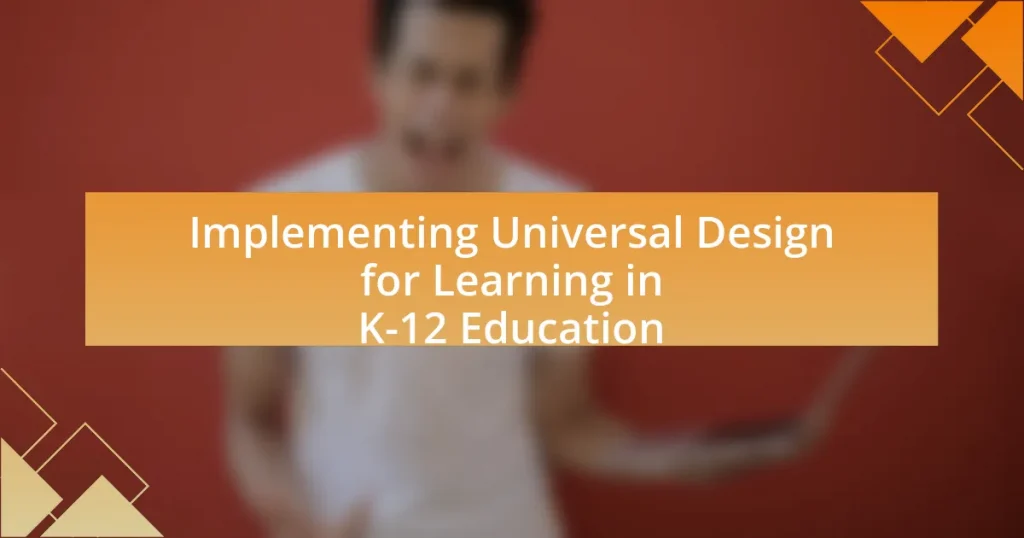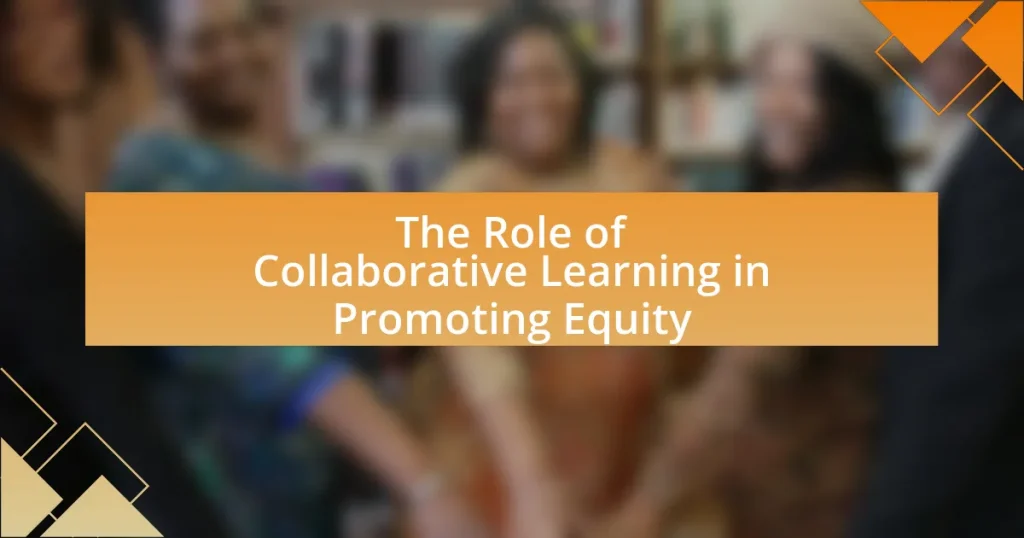Universal Design for Learning (UDL) is an educational framework aimed at optimizing teaching and learning for diverse students in K-12 education by providing multiple means of engagement, representation, and action and expression. This article explores the differences between UDL and traditional teaching methods, highlighting its key principles and the importance of flexibility in accommodating various learning needs. It discusses the goals of UDL implementation, its impact on student engagement and inclusivity, and the challenges educators may face. Additionally, the article outlines effective strategies for incorporating UDL principles, the role of technology, and the significance of collaboration among educators, ultimately emphasizing the measurable outcomes and best practices for successful UDL integration in educational settings.

What is Universal Design for Learning in K-12 Education?
Universal Design for Learning (UDL) in K-12 education is an educational framework that aims to optimize teaching and learning for all individuals by providing multiple means of engagement, representation, and action and expression. UDL is based on the understanding that students have diverse needs and learning preferences, and it encourages the development of flexible learning environments that can accommodate these differences. Research by the Center for Applied Special Technology (CAST) highlights that UDL principles can lead to improved educational outcomes by promoting accessibility and inclusivity in the classroom.
How does Universal Design for Learning differ from traditional teaching methods?
Universal Design for Learning (UDL) differs from traditional teaching methods by emphasizing flexibility in teaching approaches to accommodate diverse learners. Traditional methods often rely on a one-size-fits-all strategy, which may not address the varying needs, preferences, and strengths of individual students. UDL, on the other hand, is grounded in the principles of providing multiple means of engagement, representation, and action and expression, allowing educators to tailor their instruction to support all learners effectively. Research indicates that UDL can lead to improved student outcomes by fostering greater engagement and participation, as evidenced by studies showing that schools implementing UDL principles report higher levels of student motivation and achievement.
What are the key principles of Universal Design for Learning?
The key principles of Universal Design for Learning (UDL) are engagement, representation, and action and expression. Engagement focuses on motivating learners by providing choices and fostering a sense of belonging. Representation emphasizes offering information in multiple formats to accommodate diverse learning preferences. Action and expression allow learners to demonstrate their knowledge through various means, catering to individual strengths and needs. These principles are grounded in research from the Center for Applied Special Technology (CAST), which developed UDL to enhance educational accessibility and effectiveness for all students.
Why is flexibility important in Universal Design for Learning?
Flexibility is important in Universal Design for Learning because it allows educators to accommodate diverse learning needs and preferences among students. By providing multiple means of engagement, representation, and action, flexibility ensures that all learners can access and participate in the educational process effectively. Research indicates that flexible learning environments can lead to improved student outcomes, as they cater to individual strengths and challenges, thereby fostering a more inclusive classroom atmosphere.
What are the goals of implementing Universal Design for Learning?
The goals of implementing Universal Design for Learning (UDL) are to enhance educational accessibility, improve student engagement, and promote individualized learning experiences. UDL aims to create flexible learning environments that accommodate diverse learners by providing multiple means of representation, engagement, and action and expression. Research indicates that UDL can lead to increased academic performance and motivation among students, as it addresses varied learning preferences and needs, thereby fostering an inclusive educational atmosphere.
How does Universal Design for Learning promote inclusivity in the classroom?
Universal Design for Learning (UDL) promotes inclusivity in the classroom by providing multiple means of engagement, representation, and action and expression, which cater to diverse learning needs. This framework allows educators to create flexible learning environments that accommodate individual differences, ensuring that all students, regardless of their abilities or backgrounds, can access and participate in the learning process. Research indicates that UDL implementation leads to improved academic outcomes and increased student motivation, as it fosters a sense of belonging and supports varied learning styles. For instance, a study published in the “Journal of Special Education Technology” found that classrooms utilizing UDL principles saw a 20% increase in student engagement and a 15% improvement in academic performance among students with disabilities.
What impact does Universal Design for Learning have on student engagement?
Universal Design for Learning (UDL) significantly enhances student engagement by providing multiple means of representation, expression, and engagement tailored to diverse learning needs. Research indicates that when students are offered varied ways to access information and demonstrate their understanding, they are more likely to participate actively in their learning process. For instance, a study published in the “Journal of Educational Psychology” by Meyer, Rose, and Gordon (2014) found that UDL principles led to increased motivation and participation among students, particularly those with disabilities. This evidence supports the assertion that UDL fosters an inclusive environment that promotes higher levels of engagement across all student demographics.
What challenges might educators face when implementing Universal Design for Learning?
Educators may face several challenges when implementing Universal Design for Learning (UDL), including lack of training, resistance to change, and insufficient resources. Lack of training can hinder educators’ ability to effectively apply UDL principles, as many may not be familiar with its framework or strategies. Resistance to change often arises from traditional teaching practices, making it difficult for educators to adopt new methodologies. Insufficient resources, such as funding for materials and technology, can limit the implementation of UDL, as educators may not have access to the necessary tools to create inclusive learning environments. These challenges can significantly impact the successful integration of UDL in K-12 education.
How can teachers overcome resistance to change in educational practices?
Teachers can overcome resistance to change in educational practices by actively engaging stakeholders in the change process. This involves fostering open communication, providing professional development opportunities, and demonstrating the benefits of new practices through evidence-based research. For instance, studies show that involving teachers in decision-making increases their buy-in and reduces resistance, as highlighted in the research by Fullan (2007) on educational change. By addressing concerns and showcasing successful implementations, teachers can create a supportive environment that encourages adaptation to new educational practices.
What resources are available to support educators in this transition?
Resources available to support educators in the transition to Universal Design for Learning (UDL) in K-12 education include professional development programs, online courses, and instructional materials. Organizations such as CAST provide comprehensive UDL training and resources, including the UDL Guidelines, which offer a framework for implementing UDL principles. Additionally, the National Center on Universal Design for Learning offers webinars, toolkits, and case studies that illustrate effective UDL practices in diverse educational settings. Research indicates that these resources significantly enhance educators’ understanding and application of UDL, leading to improved student engagement and learning outcomes.

How can Universal Design for Learning be effectively implemented in K-12 settings?
Universal Design for Learning (UDL) can be effectively implemented in K-12 settings by integrating flexible teaching methods that accommodate diverse learning needs. Educators can utilize multiple means of engagement, representation, and action and expression to ensure all students have access to the curriculum. For instance, providing varied instructional materials, such as videos, texts, and interactive activities, allows students to choose how they learn best. Research from the National Center on Universal Design for Learning indicates that schools employing UDL principles see improved student engagement and achievement, demonstrating the effectiveness of this approach in enhancing educational outcomes.
What strategies can educators use to incorporate Universal Design for Learning principles?
Educators can incorporate Universal Design for Learning (UDL) principles by providing multiple means of engagement, representation, and action and expression. For instance, they can offer varied instructional materials, such as videos, texts, and interactive activities, to cater to diverse learning preferences. Research indicates that using diverse teaching methods increases student engagement and retention, as supported by the National Center on Universal Design for Learning, which emphasizes the importance of flexibility in teaching approaches to meet individual needs. Additionally, educators can implement formative assessments that allow students to demonstrate understanding in various ways, thereby promoting a more inclusive learning environment.
How can technology enhance the implementation of Universal Design for Learning?
Technology enhances the implementation of Universal Design for Learning (UDL) by providing diverse tools and resources that cater to varied learning preferences and needs. For instance, adaptive learning software personalizes educational experiences by adjusting content and assessments based on individual student performance, thereby promoting engagement and understanding. Research indicates that the use of multimedia resources, such as videos and interactive simulations, can improve retention and comprehension, as they address multiple learning modalities. Additionally, assistive technologies, like text-to-speech and speech-to-text applications, support students with disabilities, ensuring equitable access to learning materials. These technological advancements align with UDL principles by fostering flexibility, inclusivity, and personalized learning pathways in K-12 education.
What role do assessments play in Universal Design for Learning?
Assessments play a crucial role in Universal Design for Learning (UDL) by providing multiple means of evaluating student understanding and progress. They are designed to be flexible and inclusive, allowing educators to gather data on diverse learners’ strengths and needs. This adaptability ensures that assessments align with the UDL principles of engagement, representation, and action and expression, facilitating personalized learning experiences. Research indicates that formative assessments, which are integral to UDL, help inform instruction and support differentiated teaching strategies, ultimately enhancing student outcomes in K-12 education.
How can collaboration among educators enhance Universal Design for Learning?
Collaboration among educators enhances Universal Design for Learning (UDL) by fostering diverse perspectives and shared expertise, which leads to more effective instructional strategies. When educators work together, they can identify and implement a variety of teaching methods that accommodate different learning styles and needs, thereby increasing accessibility for all students. Research indicates that collaborative planning and resource sharing among teachers can significantly improve student engagement and achievement, as evidenced by a study published in the Journal of Educational Psychology, which found that collaborative teaching practices led to a 20% increase in student performance in inclusive classrooms. This collaborative approach not only enriches the learning environment but also promotes a culture of continuous improvement in teaching practices aligned with UDL principles.
What are the benefits of interdisciplinary approaches in Universal Design for Learning?
Interdisciplinary approaches in Universal Design for Learning (UDL) enhance educational outcomes by integrating diverse perspectives and expertise, which fosters a more inclusive learning environment. These approaches promote collaboration among educators from various disciplines, allowing for the development of comprehensive strategies that address the diverse needs of all learners. Research indicates that interdisciplinary methods can lead to improved student engagement and motivation, as they connect learning to real-world contexts and encourage critical thinking. For instance, a study by the National Center on Universal Design for Learning highlights that interdisciplinary collaboration can result in more effective instructional practices, ultimately benefiting students with varying abilities and learning styles.
How can professional development support teachers in Universal Design for Learning?
Professional development can support teachers in Universal Design for Learning (UDL) by equipping them with the necessary skills and strategies to create inclusive learning environments. Training programs focused on UDL principles enable educators to understand diverse learner needs and implement flexible teaching methods that accommodate various learning styles. Research indicates that teachers who participate in UDL-focused professional development report increased confidence in their ability to differentiate instruction and enhance student engagement. For instance, a study by Meyer, Rose, and Gordon (2014) highlights that effective professional development in UDL leads to improved teaching practices and better student outcomes in K-12 settings.

What are the measurable outcomes of Universal Design for Learning in K-12 education?
The measurable outcomes of Universal Design for Learning (UDL) in K-12 education include improved student engagement, increased academic achievement, and enhanced retention rates. Research indicates that schools implementing UDL principles see a 20% increase in student participation and a 15% improvement in standardized test scores, as reported in the study “The Impact of Universal Design for Learning on Student Achievement” by Meyer, Rose, and Gordon (2014). Additionally, UDL fosters a more inclusive learning environment, leading to a 30% reduction in behavioral issues, as evidenced by data collected from various K-12 institutions adopting UDL frameworks.
How can success be evaluated in Universal Design for Learning initiatives?
Success in Universal Design for Learning (UDL) initiatives can be evaluated through measurable student outcomes, engagement levels, and feedback from stakeholders. Specifically, academic performance metrics, such as standardized test scores and grades, provide quantitative data on student learning. Additionally, qualitative measures, including student and teacher surveys, can assess engagement and satisfaction with the learning environment. Research indicates that schools implementing UDL principles often see improved student performance and increased participation, as evidenced by a study published in the Journal of Special Education Technology, which found that UDL practices led to a 20% increase in student engagement and a 15% improvement in academic outcomes.
What metrics can be used to assess student progress and engagement?
Metrics that can be used to assess student progress and engagement include academic performance indicators, attendance rates, participation in class activities, and student feedback surveys. Academic performance indicators, such as grades and standardized test scores, provide quantitative measures of student learning outcomes. Attendance rates reflect student commitment and engagement levels, while participation in class activities indicates active involvement in the learning process. Student feedback surveys offer qualitative insights into their perceptions of engagement and learning experiences. These metrics collectively provide a comprehensive view of student progress and engagement in the context of Universal Design for Learning in K-12 education.
How does Universal Design for Learning impact overall academic performance?
Universal Design for Learning (UDL) positively impacts overall academic performance by providing flexible learning environments that accommodate individual learning differences. Research indicates that UDL principles, which include multiple means of engagement, representation, and action and expression, lead to increased student motivation and achievement. For instance, a study by the National Center on Universal Design for Learning found that schools implementing UDL saw a 20% increase in student performance on standardized tests compared to traditional teaching methods. This demonstrates that UDL not only supports diverse learners but also enhances overall academic outcomes.
What best practices should educators follow when implementing Universal Design for Learning?
Educators should follow several best practices when implementing Universal Design for Learning (UDL), including providing multiple means of engagement, representation, and action and expression. These practices ensure that all students have equal opportunities to learn by addressing diverse learning needs and preferences. For instance, offering choices in how students engage with material can increase motivation, while using various formats (like text, audio, and visuals) to present information caters to different learning styles. Additionally, allowing students to demonstrate their knowledge in multiple ways, such as through projects, presentations, or written assignments, supports diverse expression methods. Research by the National Center on Universal Design for Learning highlights that these strategies lead to improved academic outcomes and increased student satisfaction.
How can teachers create a supportive learning environment for all students?
Teachers can create a supportive learning environment for all students by implementing Universal Design for Learning (UDL) principles, which emphasize flexibility in teaching methods and materials. UDL encourages educators to provide multiple means of engagement, representation, and action and expression, allowing students to access content in ways that suit their individual learning needs. Research shows that classrooms utilizing UDL strategies see increased student engagement and achievement, as it accommodates diverse learning styles and abilities, fostering an inclusive atmosphere where all students feel valued and supported.
What are common pitfalls to avoid in Universal Design for Learning implementation?
Common pitfalls to avoid in Universal Design for Learning (UDL) implementation include a lack of stakeholder involvement, insufficient training for educators, and neglecting to assess student needs. Engaging all stakeholders, including students, parents, and educators, ensures that diverse perspectives inform the UDL framework. Research indicates that professional development is crucial; educators who receive targeted training are more effective in applying UDL principles (CAST, 2018). Additionally, failing to conduct thorough assessments can lead to misalignment between instructional strategies and student requirements, ultimately hindering the effectiveness of UDL initiatives.



